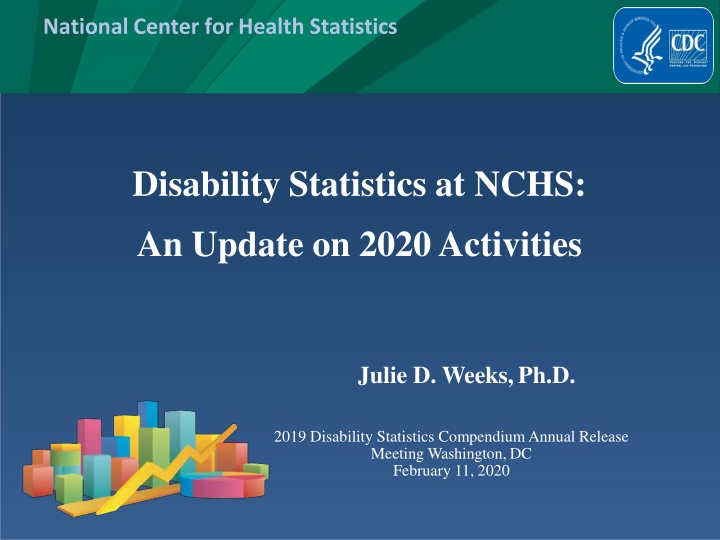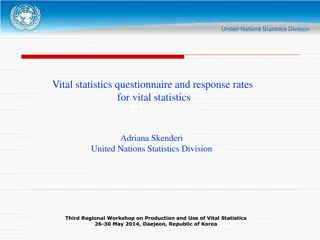Overview of National Center for Health Statistics Activities
The National Center for Health Statistics (NCHS) is the nation's principal health statistics agency, responsible for collecting, analyzing, and disseminating nationally representative health data. NCHS is part of 13 designated Federal Statistical Agencies and operates various data systems such as the National Vital Statistics System, National Health Interview Survey, and National Health and Nutrition Examination Survey. These systems provide vital information on health events, family growth, mortality data, and more to aid in understanding and addressing public health concerns.
Download Presentation

Please find below an Image/Link to download the presentation.
The content on the website is provided AS IS for your information and personal use only. It may not be sold, licensed, or shared on other websites without obtaining consent from the author.If you encounter any issues during the download, it is possible that the publisher has removed the file from their server.
You are allowed to download the files provided on this website for personal or commercial use, subject to the condition that they are used lawfully. All files are the property of their respective owners.
The content on the website is provided AS IS for your information and personal use only. It may not be sold, licensed, or shared on other websites without obtaining consent from the author.
E N D
Presentation Transcript
National Center for Health Statistics Disability Statistics at NCHS: An Update on 2020 Activities Julie D. Weeks,Ph.D. 2019 Disability Statistics Compendium Annual Release Meeting Washington, DC February 11, 2020 1
The National Center for Health Statistics The nation s principal health statistics agency since 1960. data collection, analysis and dissemination of nationally- representative health data NCHS is one of 13 designated Federal Statistical Agencies as defined by the Office of Management and Budget: bound by OMB standards and policies member of the Interagency Council on Statistical Policy the collection, compilation, processing, or analysis of information for the description, estimation, or analysis of the characteristics of groups without identifying the individuals or organizations that comprise such groups.
NCHS Data Systems Data Systems National Vital Statistics System National Health Interview Survey National Health and Nutrition Examination Survey National Health Care Surveys
The National Vital Statistics System Data Through the National Vital Statistics System, data on vital events are now published in electronic form: Vital Statistics of the United States (2018 released Feb 2020) Maternal Mortality Data (2018 released Feb 2020) National Vital Statistics Reports Additional programs related to the National Vital Statistics System include: National Survey of Family Growth (2015-2017) information on family life, marriage and divorce, pregnancy, infertility, use of contraception, and general and reproductive health from a nationally representative, civilian sample of women and men 15-49 years of age National Death Index (2018) a centralized database of death record information
The National Health Interview Survey The principal source of information on the health of the civilian noninstitutionalized population of the United States since 1957 Annual data collection from 30,000 adults and 10,000 children Redesigned questionnaire fielded in January 2019 Data release in 2020 Disability now part of the Early Release program Provides information on the health status of persons with disability, as well as: Demographics Health care access and utilization, and insurance Health behaviors and risk factors Participation (social, work, civic)
Functional Limitation among adults 18+, U.S. 2010-2017 SOURCE: NCHS, National Health Interview Survey (NHIS).
Self-Rated Health & Disability Status among adults 18+, U.S. 2018 SOURCE: NCHS, National Health Interview Survey.
Employment & Disability Status among adults 18+, U.S. 2018 SOURCE: NCHS, National Health Interview Survey.
The National Health and Nutrition Examination Survey Designed to assess the health and nutritional status of the U.S. civilian noninstitutionalized population. The survey is unique in that it combines interviews and physical examinations. Annual data collection from 5,000 adults and children Redesigned questionnaire fielded in January 2019 Two-year release cycle (2019-2020) Anticipated data release in Fall 2021 Questionnaires for 2019 now available online Provides information on persons with disability: Interview component: demographic, socioeconomic, dietary, and health status Examination component: medical, dental, and physiological measurements, as well as laboratory tests
Measures Development & Testing Domains of functioning: Psychosocial functioning Participation Special populations: Washington Group Child Functioning Module In-school and out-of-school populations Washington Group Labor Force Disability Module Intellectual and Developmental Disability Administration characteristics: Web-based surveys Instrument location
Current IDD Testing Activities Onset question to be tested, along with other physical and social functioning questions Consent forms developed Study design, including 40 Rs (representative in age, race and education) NCHS IRB review of study protocols OMB review of study Recruitment strategies, including service providers, advertisements, word of mouth, personal visits Started summer 2019
Preliminary Experiences Recruitment challenges Significant organizational investment Incorporation of addition recruitment materials and techniques Finding the right administrator for access Scheduling the interview Time investment Interview location Length of interviews Interview burden Self vs. proxy response
Thank You National Health Interview Survey https://www.cdc.gov/nchs/nhis/index.htm National Health and Nutrition Examination Survey https://www.cdc.gov/nchs/nhanes/index.htm Washington Group on Disability Statistics http://www.washingtongroup-disability.com/
A number ofmeasurement developments National Health Interview Survey(NHIS) Nationally-representative, annual household interview survey (30KHHs) Redesigned content launched in January 2019 (release June2020) Adults = 18+ (self) and Children = under 18(proxy) New functioningcontent National Health & Nutrition ExaminationSurvey Nationally-representative, interview survey w/ physicalexam New design: 2-year data cycle beginning 2019-2020 (release Fall2021) Adults = 18+ (self) and Children = under 18 (proxy 5-15, self16+) New functioningcontent Other functioning-relatedactivities Special populations data collection and questiondevelopment Washington Group questionuptake
NHIS Modules A nnual Core - Sample Adult(n 30,000) Self-response (unlessunable) Fielded with fixedperiodic Demographics, family income. health insurance, health care/utilization/status, chronic conditions, WGfunctioning Relevant family-leveldata ity Annual Core - Sample Child(n 10,000) Knowledgeable adult responds forchild Fielded with fixedperiodic Relevant family-leveldata ity Rotating Core Dental and mental health, rotating conditions, pain,detail on employment and injuries, health behaviors Newer topic areas Expandeddetail Varyingperiodicity SponsoredSupplements Sustaining sponsors 1- or 2-yearmodules 5 min orless https://www.cdc.gov/nchs/nhis/about_nhis.htm
Annual NHIS Functioning Content Adults1 (18+yrs) Adults2 (18+yrs) Children3 (2-4yrs) Children3 (5-17yrs) Seeing Hearing Mobility Communication Cognition Self-care Seeing Hearing Mobility Communication Seeing Hearing+ Mobility+ Communication Cognition+ Self-care Upperbody Anxiety Depression Pain* Fatigue* Seeing Hearing Mobility Communication Cognition Self-care Fine motorskills Anxiety Depression Playing Controllingbehavior Learning Controllingbehavior Learning Coping withchange Relationships 1WG Short Set on Functioning 2WG Extended Set on Functioning 3WG-UNICEF Child Functioning Modules * Pain and fatigue collected on a rotatingbasis.
Additional NHIS Functioning Content Work limitation: Are you limited in the kind or amount of work you can do because of a physical, mental or emotional problem? Social activity limitation: Because of a physical, mental, or emotional condition, do you have difficulty participating in social activities, such as visiting friends, attending clubs and meetings, or going to parties? Participation limitation: Because of a physical, mental, or emotional condition, do you have difficulty doing errands alone such as visiting a doctor's office or shopping? Additional mental health measures: Adults: K6, PHQ-8, GAD-7 (not at the same time) Children: SDQ, SDQ-Impact
NHANES Functioning Content Adults1 (18+yrs) Adults2 (18+yrs) Children3 (5-17yrs) Seeing Hearing Mobility Communication Cognition Self-care Seeing Hearing+ Mobility+ Communication Cognition+ Self-care Upperbody Anxiety Depression Seeing Hearing Mobility Communication Anxiety Depression Controllingbehavior Learning 1WG Short Set on Functioning 2WG Extended Set on Functioning 3WG-UNICEF Child Functioning Modules
Additional NHANES Functioning Content Work limitation: Are you limited in the kind or amount of work you can do because of a physical, mental or emotional problem? Social activity limitation: Because of a physical, mental, or emotional condition, do you have difficulty participating in social activities, such as visiting friends, attending clubs and meetings, or going to parties? Participation limitation: Because of a physical, mental, or emotional condition, do you have difficulty doing errands alone such as visiting a doctor's office or shopping? Additional mental health measures: Adults: PHQ-9, GAD-7























